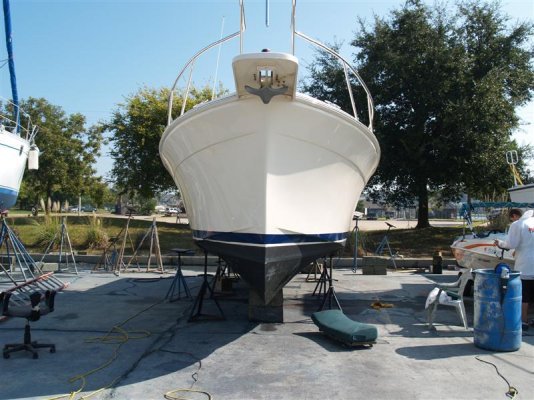Nomad Willy
Guru
John,
Thats where the planing surface is supposed to be.What part of your boat is still in the water at 25knts? A full planing hull has a flat or at least a straight run aft with sharp hard chines. It also has fairly low weight and high power. A semi displacement and a semi planing hull ( SD @ SP ) is harder to classify. The word " partly " is used to define " semi ". So an SD hull is like a planing hull but partly not. An SP hull is like a disp. hull but partly not. So Carey's lobster hull is a SD hull. All it would need to become a planing hull is to have hard chines aft. An SP hull is one that partly planes. It is slower than an SD hull and faster than an FD ( full displ hull ). A FD hull is usually defined as a hull that operates at or below 1.34 x sq. root WLL.If this is a speed / length ratio of one then FD hulls operate below an SL of 1.4T. Here are three ways to identify a FD hull. It will not be possible to drive it to a SLR of 2 ( about 15 knts for a 30' boat ). Also at about 75% power it's bow will not have begun to rise. This happens at about a SLR of about 1. With a good working load 100% of the transom will be out of the water.. as in not submerged.The geryest area is between SD and SP hulls. Some boats that I think are in this zone are: Eagle 32 @ 40, Nordhaven 35 @ 47, some Devlins and the Selene Archer 36. The GBs and NTs are in the narrow grey area between FP andSD hulls.
Eric Henning
30'Willard
Thorne Bay AK
Thats where the planing surface is supposed to be.What part of your boat is still in the water at 25knts? A full planing hull has a flat or at least a straight run aft with sharp hard chines. It also has fairly low weight and high power. A semi displacement and a semi planing hull ( SD @ SP ) is harder to classify. The word " partly " is used to define " semi ". So an SD hull is like a planing hull but partly not. An SP hull is like a disp. hull but partly not. So Carey's lobster hull is a SD hull. All it would need to become a planing hull is to have hard chines aft. An SP hull is one that partly planes. It is slower than an SD hull and faster than an FD ( full displ hull ). A FD hull is usually defined as a hull that operates at or below 1.34 x sq. root WLL.If this is a speed / length ratio of one then FD hulls operate below an SL of 1.4T. Here are three ways to identify a FD hull. It will not be possible to drive it to a SLR of 2 ( about 15 knts for a 30' boat ). Also at about 75% power it's bow will not have begun to rise. This happens at about a SLR of about 1. With a good working load 100% of the transom will be out of the water.. as in not submerged.The geryest area is between SD and SP hulls. Some boats that I think are in this zone are: Eagle 32 @ 40, Nordhaven 35 @ 47, some Devlins and the Selene Archer 36. The GBs and NTs are in the narrow grey area between FP andSD hulls.
Eric Henning
30'Willard
Thorne Bay AK

